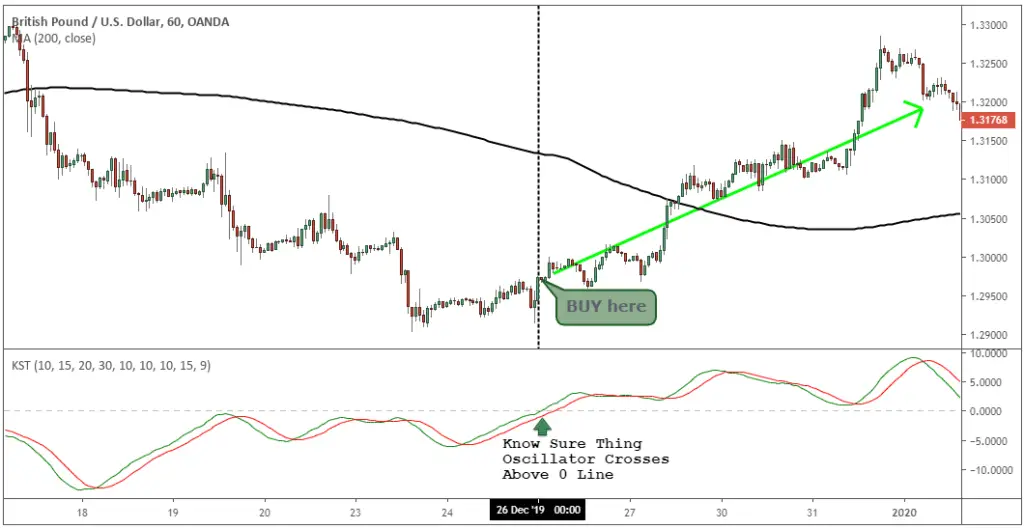The Alexander Elder trading strategy is also known as the Triple Screen trading system combines oscillators with trend-following tools in order to refine the performance of both. This is a practical guide to the Alexander Elder trading system that will teach you how to trade for a living.
If this is your first time on our website, our team at Trading Strategy Guides welcomes you. Make sure you hit the subscribe button, so you get your Free Trading Strategy every week directly into your email box.
The Elder trading system came in response to a well-known problem that certain technical indicators only work in a certain market environment. For example, trend-following indicators perform well only when the market is trading, and tend to give false signals when the market is range-bound.
On the same note, oscillators work when the market is range-bound, and tend to give false signals when the market is trading.
Throughout this guide to trading for a living, we’re going to break down how to use the Alexander Elder trading system.
While it was first designed for stock trading, the Elder system can be used in forex, futures, commodities, and cryptocurrencies.
Let’s get started with an introduction to the Alexander Elder trading strategy.
See below:

The Alexander Elder trading strategy also known as the Triple Screen trading system was revealed to the general public in the Trading for a Living Alexander Elder book.
As the name of the Elder trading system suggests there are three “screens” that we apply to every trade.
The three screens used by Alex Elder can be summarized as follows:
- First Screen used for establishing a trading bias.
- The second Screen applies technical indicators to identify retracements against the trading bias established earlier.
- The third Screen is used for timing your entries using short-term breakouts in the direction of your trading bias.
As you can probably tell, the Alex Elder trading rules involve the use of multi-timeframe analysis.
The first screen starts with higher degree time frames and subsequently we downgrade our time frames lower as we progress with the 3 screens.
Learn the advantages that come with trading multiple time frames HERE.
In total, trading Alexander Elder system involves using three different time frames:
- The long-term trend – Alex Elder calls this as being the tide.
- The medium-term trend – this trend is also known as the wave.
- The short-term trend – it’s also referred to as the ripple.
So far, so good.
Now, let’s get into more details and learn how Dr. Alexander Elder has taught the three-screen method n the New Trading for a Living by Alexander Elder book. The entire audiobook is available here and takes about three hours to finish. Below, we will break down the most important things to know about Dr. Alexander Elder’s important work.

Here we’re going to study Alex Elder’s 3 screen method and see the main characteristics and rules you need to follow.
Let’s begin…
Elder Trading System – First Screen
According to Dr. Alexander Elder’s rules, the first screen starts with a time frame bigger than the time frame you’re looking to trade.
For example, if your preferred time frame is the daily chart, you first start by looking at higher time frames like the weekly chart. This is the chart where you’re going to apply the trend-following indicators to establish your bias.
If the trend is up, we only look for buy signals. Inversely, if the trend is down, we only look for sell signals. By going through this process, we can filter out trades against the primary trend.
Let’s move on…
Elder Trading System – Second Screen
Dr. Elder’s trading rules recommend downgrading our time frame lower. If during the First Screen we used the weekly chart, the next lower time frame we can use is the daily chart. Now, we look for price movements against the tide.
In other words, we’re waiting for pullbacks or what Elder system calls the “wave”.
Learn the most profitable approach to profit from pullbacks HERE.
This in return will help us spot good times to execute your trades. The Elder trading system uses oscillators to identify these price movements against the tide. Read more about volume oscillators.
For example, if the weekly tide is up, then we’re looking for the oscillator to identify when the wave is down and that’s when we buy. On the other hand, if the weekly tide is down, then we’re looking for the oscillator to identify when the wave is up and that’s when we sell.
The last part of the Alexander Elder trading strategy is where all the fun begins.
Let’s see how we can time our trades.
Elder Trading System – Third Screen
The Elder trading system refers to the third screen as the execution screen. Or, in other words, this time frame is used for better timing our entries.
We have to downgrade our time frame lower.
The next in order time frame is the 4h chart.
When the trend on the third screen aligns with the trend of the first screen that’s the optimal trade entry. To time your trades, Alexander Elder uses a trailing stop in order to seize small breakout in the direction of the main trend.
Basically, that’s what the Elder system is all about.
Now, there is one more concept that Dr. Alexander Elder has taught in his book, Trading for a Living.
How to select your time frames to trade the was Alexander Elder trader does it.
See below:
Dr. Alexander Elder Rules on how to Use Multiple Time Frame Analysis

The Alexander Elder trading strategy uses a technique to balance out the different information that comes from looking at different time frames.
The Elder’s technique involves using a factor of four to six to classify his time frames.
Let me explain…
Alexander Elder factor of 4 to 6 can help us divide our charts into smaller units of 4, 5, or 6.
The way to go about it is to first select your larger time frame (first screen) and then downgrade the charts lower by a factor of 4, 5, or 6.
For example, if your first screen is the daily chart and we downgrade our time frame by a factor of 6, the next time frame would be the 4-hour chart.
Four multiplied by 6, it gives us 24-hours, which is a day.
Using a factor of 4 will require us to downgrade our charts to the 8-hours time frame.
Now, to find your execution screen aka the third screen, we have to downgrade our time frames lower one more time. If we used a factor of 4, the next down in line time frame is the 1-hour chart.
So, the 1-hour time frame is our third screen.
Note* if after downgrading the charts, the exact time frame doesn’t exist, then as a general rule the closest one is used.
This is the method used by Dr. Alexander Elder to select his time frames.
The table below highlights a possible set of time frames that you can use.

For example, if the long-term trend is the 4h time frame, the medium-term trend should be the 1h time frame while the short-term trend should be the 15 minutes TF. We used a factor of 4 to obtain the 3 screens.
Now…
Let’s now put into practice what Alexander Trading for a Living book is teaching us.
See below:
Alexander Elder’s “The New Trading for a Living Book” emphasized that the Triple Screen system can’t be used to provide concise buy and sell signals. Alexander Elder trading strategy works as a methodology of verification of the trend from a one-time frame to the next.
The Elder system doesn’t provide rigid criteria for entry.
So, this is a great opportunity to incorporate your own edge into the system.
The Triple Screen trading strategy blended together multiple indicators like the MACD indicator and the Force index to identify entry points.
Let’s move on…
When to buy using the Alexander Elder Trading Strategy
According to Alex Elder trading rules, the best moment to buy is when an uptrend has undergone a pullback and has started to resume the bullish trend.
For this example, we’re going to use as the first screen the daily chart.
So, the daily chart is used to determine the long-term trend. And, for this purpose, the 200-day moving average, which is the standard measurement of bullish and bearish trends, will be our trend filter.
Check if the price is trading above the 200-day moving average to confirm the uptrend.

The next step is to downgrade our time frame to the second screen.
If the first screen used the daily chart, the next in line time frame is the 4-hour chart.
The middle time frame is going to be used to spot corrections against the bullish trend.
For this purpose, we’re going to use the MACD indicator applied to the 4-hour time frame.
We wait for the MACD lines to rise from the oversold condition and the moving average slops have turned upwards again.

Note* Dr. Alexander Elder recommends to use the Force index or another momentum oscillator to add more confluence.
The next step is to downgrade our time frame to the third screen.
If on the second screen we used the 4-hour time frame, the next in line time frame is the 1-hour chart.
The short-term time frame is going to be used to time the market.
However, since Alexander Elder doesn’t provide rigid rules for entry and exit, it’s time to reveal the Ace from our sleeve. For timing the market with great results, we’re going to use the Know Sure Thing Indicator.
Learn more about the Know Sure Thing oscillator, a powerful leading indicator that can help you boost your profits HERE.
On the 1-hour time frame, we wait for the Know Sure Thing oscillator to cross above the zero lines to trigger a buy signal. The KST indicator is great because it also signals burst in momentum.
What does it mean for your trade?
Simply, you get the chance for your trade to show a profit right from the start.
See the chart below:

Note* for sell signals the same trading rules can be applied but in reverse.
The Alexander Elder trading strategy can be used as a building block for your own trading strategy. The Elder trading system has the advantage of using multi time frame analysis to verify the market trend in several degrees.
According to Dr. Alexander Elder, the single most important factor that will dictate your profitability is the quality of the records that you keep. We succeed in some trades and make mistakes in others. However, we can only improve our trading strategy only if we learn from both winning and losing trades.
And, that’s why Dr. Elder believes that journaling is an absolute must as it makes you into your own teacher. You may also be interested in the volume oscillator strategy, seen here: https://tradingstrategyguides.com/volume-oscillator/.
Thank you for reading!
Feel free to leave any comments below, we do read them all and will respond.
Also, please give this strategy a 5 star if you enjoyed it!

With over 50+ years of combined trading experience, Trading Strategy Guides offers trading guides and resources to educate traders in all walks of life and motivations. We specialize in teaching traders of all skill levels how to trade stocks, options, forex, cryptocurrencies, commodities, and more. We provide content for over 100,000+ active followers and over 2,500+ members. Our mission is to address the lack of good information for market traders and to simplify trading education by giving readers a detailed plan with step-by-step rules to follow.



